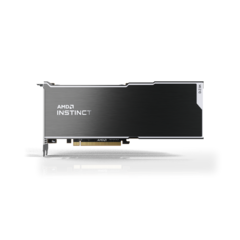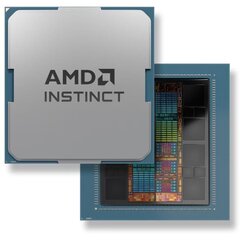AMD Instinct MI210 Graphic Card - 64 GB HBM2e - 2x Slot - PCIe 4.0 - 1.6 GHz - 100-300000008H
BUS: PCIe 4.0 x16 Memory size: 64 GB Memory type: HBM2e Stream processors: 6656 Theoretical performance: 22,6 TFLOP
| Product code | 214.170491 |
|---|---|
| Part number | 100-300000008H |
| Supermicro Part No. | GPU-AMDMI210-PCIE-0008H |
| Manufacturer | AMD |
| Availability |
In stock 0 pc
Stock allocation and delivery options
Delivery to selected address Monday 6. 10. at the latest Wednesday 15. 10. |
| Supplier availability | In stock 2 pc |
| Warranty | 24 months |
| Weight | 2 kg |
 Server system integrator & worldwide shipping
Server system integrator & worldwide shipping Personal approach and tailor-made servers
Personal approach and tailor-made servers NBD warranties & cross-shipping
NBD warranties & cross-shipping Private cloud infrastructure
Private cloud infrastructure Pre-sales & After-sales support
Pre-sales & After-sales support
Detailed information
AMD Server GPU
AMD, a leading provider of high-performance computing solutions, introduces a comprehensive range of professional-grade graphics cards designed specifically for server infrastructure in both PCIe and OAM formats. AMD emphasizes its commitment to delivering seamless graphics performance across all aspects, from high-speed rendering powered by exceptional hardware capabilities to unmatched color accuracy.
Floating point
Using the FLOPS unit, we can estimate the raw performance of graphics cards today. It indicates how many operations per second a graphics card can perform, allowing us to compare them against each other. However, these values can vary depending on the bit size of the floating-point (FP) representation. The larger the bit size, the more accurate the calculations, but also the fewer of them there are. Since gaming PCs need precise values for smooth operation, they mainly use 32-bit FP (or FP32). On the other hand, Deep Learning does not necessarily require such precise calculations, and therefore AI graphics cards use FP8. This drastically reduces the accuracy, but on the other hand increases the number of calculations.
Graphics memory
VRAM, these days primarily of GDDR type, is a synchronous memory, similar to standard RAM. However, in the case of graphic memory, memory chips with faster throughput and multiple data transfer rates are concerned. The result is a much faster buffering of data that the graphics card or coprocessor calculates and passes to the processor.
PCI Express
PCI Express is an interface that usually takes the form of an expansion slot to ensure the modularity of the entire system, whether it is GPU, network cards, controllers, M.2 drives or other expansion cards. It is true that the newer the generation and wider the interface, the higher the performance and throughput. Most modern graphics cards use 16 lanes to connect with the processor. Currently, the most up-to-date generation is PCI Express generation 6.0 with a speed of 7.5 GB/s per lane.







